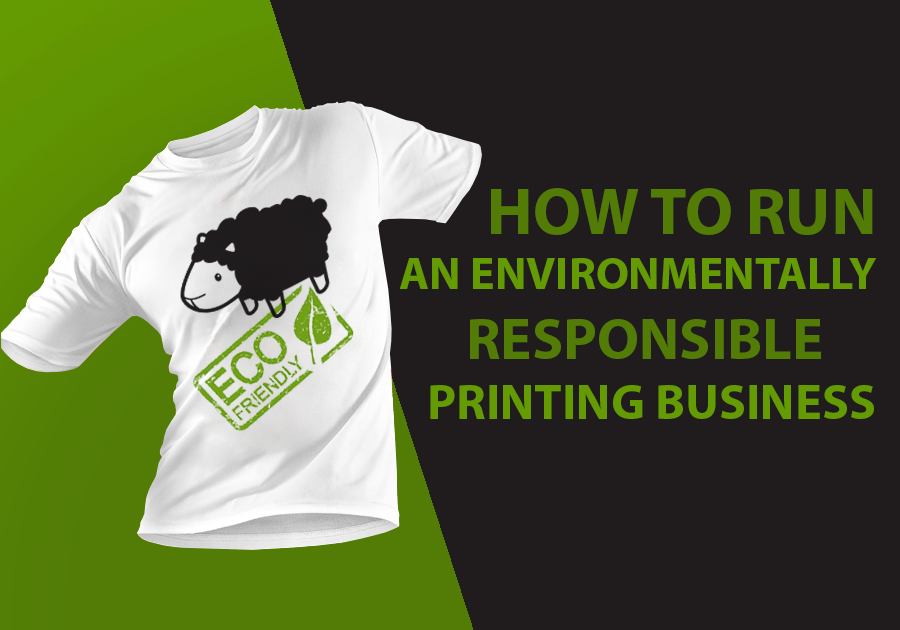Eco-Conscious / Eco-Friendly, Mens Clothing, Style, Uncategorized, Urban Clothing, Women Clothing
How To Run An Environmentally Responsible Printing Business
It is realistically necessary to run an ecologically friendly printing business since customers are increasingly expecting you to limit your influence on the environment as part of your ethical business practices. So, absolutely, some customers may decide to purchase elsewhere if you don’t act sustainably. The good news is that sustainability benefits not only the environment but also the bottom line of your store. The value of sustainability for your screen printing company cannot be understated, not least because it connects our way of life today to what will exist in the future. Some customers are receptive when you emphasize sustainability. But most significantly, we know that pursuing sustainability is the proper course of action.
Here are some ideas you may start mulling over for your brick-and-mortar business or online apparel company right away.
1- Examine strategies for creating garments that are environmentally beneficial.
Compared to the discussion of plastisol vs. water-based screen printing inks, you adopt a much broader perspective in this instance. A more environmentally friendly method would be print-on-demand combined with digital printing (like DTG). In the past, it was common practice to print products in bulk, send them to a warehouse, sort them, and store them there before delivering them to the final customer. Now, when a consumer places an order online, you print and mail out the order, eliminating the entire procedure. As compared to an online store stocking hundreds of patterns, the approach is more sustainable because you only create the designs that sell.
2- Purchase a lot of eco-friendly cloth or fabric.
Businesses that screen-print apparel have been seen to favor garments made of eco-friendly materials. For instance, when clients visit their showroom or purchase online, they will predominantly find apparel made from recycled materials, organic cotton that is cultivated in the United States, or clothing that was produced using environmentally friendly methods. Sustainable practices are important to BO KRISTO. Our general policy is zero waist. as such; little to no waste should go to landfills. Therefore we continuously make sustainable decisions, either on our own or in partnership with various suppliers or distributors and you can too.
3- Consider a green or sustainable approach to packaging
You are probably aware that the mailer you are using right now are destined for a landfill. If you’re shipping T-shirts or other items as part of a print-on-demand service or online store, why not wrap that order in something better? If your store employs print on demand, researching a business that creates biodegradable envelopes, such as noissue, is a fantastic option. The packaging for these goods does not need to be recycled because the recipients can compost it at home or throw it away with regular rubbish.
4- Adapt to new Eco-Friendly Technology.
If you want to dramatically reduce the amount of film in your store, think about CTS as an investment. In case you were unaware, CTS technology expedites printer screen preparation. You won’t need pricey film positives or the equipment to make them with this technique. You’ll recover every minute spent on pre-press, of course. Shop owners who have implemented CTS have repeatedly reported having more space in their establishments and, in many cases, being able to grow their business because they no longer need space for film storage.
5- Investigate and re-examine your washout booth.
While you might think that you are properly getting rid of your screen-printing inks and chemicals, it’s possible that your booth is tainting the local water supply. This is because it’s possible that when you flush your sink, emulsions like inks, oils, and polymers could end up in the sewage. It’s also possible that this could damage your pipes, which would be expensive. Installing a water-filtration system in your sinks that circulates water through tubing will subject your water to many filters. You can eliminate most of the sediments and chemicals that can clog pipes and pollute water by doing this before they leave your store and enter the sewers. You need to make sure you aren’t throwing your screens and squeegees into a bucket. This helps to stop the gloomy chemicals from getting into your water system. You can recycle your inks as well to increase the sustainability of your printing process.
We hope that this post has provided you with some excellent advice on how to open a store that is environmentally friendly or, if you have already begun down that path, how to make it even more ecologically friendly. In conclusion, we urge you to think over the following evidential data to understand how making your store more sustainable will help your company flourish going forward:
-If you engage in corporate responsibility, the sales of your store could increase by up to 20%.
-If the employing employer doesn’t demonstrate good corporate responsibility, 64% of younger job applicants will pass on the opportunity.
-66% of consumers say they would be willing to pay more for products that are more environmentally friendly.
-Consumers claim that 87% of them would choose to purchase an environmentally friendly product if given the choice.
-There is a higher (92%) level of trust in environmentally conscious brands.
-Companies that promote environmental concerns have an 88% higher level of customer loyalty.







Your writing has a way of resonating with me on a deep level. I appreciate the honesty and authenticity you bring to every post. Thank you for sharing your journey with us.
Your Words Are Too Kind. Thank you so much!! —It truly means a lot. I believe authenticity is especially important when discussing topics like running an environmentally responsible printing business. It’s not always easy, but sharing the real challenges and solutions helps others see that sustainability is both achievable and worthwhile. From sourcing recycled paper and using eco-friendly inks to investing in energy-efficient equipment and reducing waste, every choice matters. I’m grateful to be able to share this journey and hopefully inspire others to make more conscious decisions in their own businesses.
Rattling nice pattern and fantastic subject material, nothing at all else we require : D.
Thank you! We’re glad you appreciate the content. When it comes to running an environmentally responsible printing business, the key is maintaining that same high-quality standard while minimizing environmental impact. This includes using recycled or sustainably sourced paper, soy- or vegetable-based inks, energy-efficient equipment, and implementing waste reduction and recycling practices. It’s not just about producing great work—it’s about doing it in a way that’s sustainable for the planet too.